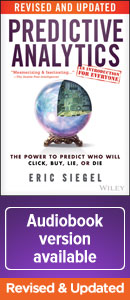Conference Day 1: Tuesday, March 31, 2015
8:00-8:45 • Room: Grand Assembly
Registration & Networking Breakfast
Conference Chair Welcome
8:50-9:40am Room: Golden Gate A
Keynote
Case Study: Smarter Remarketer
The Revolution in Retail Customer Intelligence
In this new era of Big Data, retailers collect data in ever-increasing volume and variety. In the midst of Big Data, a revolution is taking place in how retailers gain insights about customers, whether they interact with the brand online, in stores, or both. This session will describe the transition from reporting to data-driven decisions using predictive analytics. Success requires collecting the right data, creating informative derived attributes, making this data accessible in a timely manner, and building predictive models. Examples, drawn from real-world retailers, will include shopping cart funnel management, shopping cart abandonment, marketing attribution, churn, and purchase propensity.
Also sign up for a one-day workshop by Dean Abbott:
Advanced Methods Hands-on:
Predictive Modeling Techniques
Supercharging Prediction:
Hands-On with Ensemble Models
[ Top of this page ] [ Agenda overview ]
 9:40-10:00am Room: Golden Gate A
9:40-10:00am Room: Golden Gate A
Diamond Sponsor Presentation
New Challenges: From Predictive to Prescriptive to Automated Analytic
In a recent Wall Street Journal article, Thomas Davenport (WSJ, January 14, 2015) argues that the next stage in analytics maturity -- following prescriptive analytics – will be Automated Analytics. Across all application domains the exponential growth of data sources has created equally growing opportunities for analytic applications based on those data, to address critical high-ROI use cases. But as most CIO’s know the availability of data-scientist or otherwise qualified resources will not keep pace, necessitating new approaches to take advantage of these opportunities. This presentation will provide an overview of the predictive-prescriptive-automated analytics progression, what automated analytics platforms look like today, and what they will likely look like in the future. Examples will be discussed to illustrate new challenges, and how to address them with existing and emerging tools and technologies for automated analytics.
10:00-10:30am • Room: Salon 8/9
Exhibits & Morning Coffee Break
10:30-11:15am • Room: Salon 4-6
 Track 1: Sales Analytics
Track 1: Sales Analytics
Case Study: Paychex
Shaping Sales Strategy with
Predictive Analytics
Predictive modeling brings art and science together and without it many strategic decisions are left to instinct. This can lead to missed opportunities in the age of big data. Paychex leveraged expertise in Predictive Analytics to add an empirical layer to sales strategy decisions. With the addition of models to predict likely sales units and establish a yardstick to measure sales value by zip code, sales management became statistically informed as they made decisions regarding quota setting, territory alignment and market expansion. This session describes how Predictive Analytics at Paychex was granted a seat at the strategic table.
10:30-11:15am Room: Golden Gate A
 Track 2: Methods; Marketing Applications
Track 2: Methods; Marketing Applications
Data Driven Customer
Segmentation Methods
The goal of customer segmentation is to better understand our customers so that we can serve them better for which they will, hopefully, reward us. Just as an organization interacts with its customers at many different levels, multiple segments are needed depending on how they will be used. Strategists may like to think in terms of archetypes or persona. The front-line marketer needs to know current interests.
We will cover a range of examples. For each mini-case study you will learn the real-world application of the segmentation scheme, the algorithm used, and how best presented to marketers and management.
[ Top of this page ] [ Agenda overview ]
11:20am-11:40am • Room: Salon 4-6
 Track 1: Sales Analytics
Track 1: Sales Analytics
Case Study: RingCentral
Going Beyond BI: How RingCentral Uses Predictive Analytics to Drive Revenue Growth
Serving 300,000+ customers globally, RingCentral presents a case study around using predictive analytics to better analyze their pipeline and forecast their quarterly performance. RingCentral's global sales operations team initially used spreadsheets and BI tools to analyze their Salesforce.com CRM data. But with their growth and large volume of deals, these approaches were not able to deliver predictive and actionable insights in a timely basis. By implementing a predictive cloud analytics solution, they have delivered a management tool to run the sales organization more effectively and to predict future results accurately. Results and lessons learned will be presented.
11:20am-12:05pm Room: Golden Gate A
 Track 2: Social Data
Track 2: Social Data
Think Link: Connecting to the Power of Social Networks with no
Programing with NodeXL
Networks are collections of connections -- they are everywhere once you start to look. Learn how to collect, analyze, visualize, and publish insights into connected populations. Using the free and open NodeXL addin for Excel, anyone who can make a pie chart can now make a network chart. Create insights into social media, collaboration, organizations, markets, and other connected structures with just a few clicks. Easily publish reports with visualizations and content analysis. Apply social network analysis to your own brands, email, discussions or web sites.
Also sign up for Marc Smith's one-day workshop, Big Data: Proven Methods You Need to Extract Big Value.
11:45am-12:05pm • Room: Salon 4-6
 Track 1: Maritime Vessel Safety
Track 1: Maritime Vessel Safety
Case Study: RightShip
The Impact of Predictive Analytics on Maritime Safety and Efficiency
Over 90% of world trade is carried by sea, and RightShip's highly regarded online vetting system provides data and risk evaluations on over 75,000 vessels in the world fleet.
In 2014 RightShip transformed their online vetting system, moving from an expert opinion model to predictive analytics.
Bryan will discuss the internal journey that RightShip undertook not only to devise and implement the new system, but the change in mindset that was necessary for the organization to come to grips with what constituted predictive analytics, and the impact this would have on the shipping industry.
[ Top of this page ] [ Agenda overview ]
12:051:10pm • Room: Salon 8/9
Lunch in the Exhibit Hall
 12:051:10pm Room: Golden Gate A
12:051:10pm Room: Golden Gate A
Lunch & Learn
Driving Unified Customer Experience Insights and Impact: A Case Study Presentation with Lenovo
Lenovo was interested in learning more about the impact on NPS measurement of customer experiences through the decision making process. How does the customer experience change at each stage? What are the reasons? Where can Lenovo execute or where do they have to put drivers? This insightful presentation will share with attendees how Lenovo embarked on a course to map and then measure customer experiences across the customer journey (buying cycle) by leveraging a Big Data analytics framework. Together Ashish Braganza, Director of Global Intelligence with Lenovo, and Anees Merchant, Senior Vice President Digital with Blueocean Market Intelligence, will share examples of the final output, best practices to consider and pit falls to avoid when implementing something similar within your organization.
1:10-1:55pm Room: Golden Gate A
Keynote
UPS Analytics The Road to Optimization
Turning data into a business advantage through optimization is the goal of most organizations. The ever growing availability of data, along with expanding computing power and tools, opens the door to businesses gaining competitive advantage through analytical processes and skill.
Jack Levis, senior director of process management at UPS, will share his experiences and best practices to compete with analytics, requiring organizational support in the form of data, tools and senior management commitment. Analytics takes the general forms of:
- Descriptive analytics Analysis of historical data
- Predictive analytics Prediction of probabilities of future trends
- Prescriptive analytics Evaluate new ways to operate
UPS has gone through a long evolution in moving up this analytical hierarchy which required organizational commitment and significant process change. While many lessons were learned along the way, the end result has been reduced cost, improved service to customers, and a data driven architecture for the future.
This presentation will show how UPS built upon a culture of engineering and quantitative analysis. Those core competencies are the foundation of systems reengineering efforts that use advanced analytics and connected devices. Examples of the changed processes will be presented as well as lessons learned from the journey.
 1:55-2:15pm Room: Golden Gate A
1:55-2:15pm Room: Golden Gate A
Diamond Sponsor Presentation
Leveraging Best Practices with Oracle Advanced Analytics
In the era of Big Data, enterprises are acquiring increasing volumes and varieties of data from a rapidly growing range of internet, mobile, sensor and other real-time and near real-time sources. The driving force behind this trend toward Big Data analysis is the ability to use this data for “actionable intelligence”—to detect patterns and anticipate behavior and to deliver actionable information where and when and it is most needed. Oracle Advanced Analytics Option extends the Oracle Database to a powerful and scalable “big data” predictive analytics platform. By “moving data mining algorithms to the data” to run as native analytical SQL functions that mine all data types (structured, unstructured and transactional) and can mine data in its natural star schema form, Oracle eliminates data movement, automates knowledge discovery and accelerates the transformation of “big data” to “actionable insights” from days/weeks to minutes/hours. The Oracle Database combined with the Big Data Appliance and Oracle Business Intelligence offers a powerful platform for data management, advanced analytics and enterprise business intelligence. Come learn best practices and customer examples for exploiting Oracle’s scalable, performant and secure in-database analytics capabilities to extract more value and actionable intelligence from your data and more importantly, to rapidly deploy predictive analytics throughout the enterprise.
 2:15-2:35pm Room: Golden Gate A
2:15-2:35pm Room: Golden Gate A
Diamond Sponsor Presentation
Next Generation Customer Insights from Multichannel:
A Case Study in the Use of Machine Learning and NLP
The problem is not a lack of data but to identify actionable Insights Intelligence that is contained in the deluge of unstructured text data every company has access to. In this time of instant communication, Companies struggle just to keep up with the ever changing, ever relevant voice of the customer in brand across multiple channels. Do you really know what your customers are saying about your brand, your services, your product's experiences -- right now? Can you act on that information, in near-real time and assign accountability to the right resources, for a measurable purpose?
Having up-to-date, actionable, measurable, high confidence Insights Intelligence can be extremely valuable and a competitive differentiator. This can be used to impact business in many ways such as: improve features, change brand perception, and provide an enhanced customer experience.
The key to acquire Insights Intelligence is for data scientists to classify (not cluster) large amounts of data, quickly, into repeatable, trend-able, high-confidence themes, and then action the Insights generated to appropriate business functions.
Mark Eduljee from Microsoft and Ashwin Mittal from Blueocean Market Intelligence will show how new thinking in unstructured data analytics using machine learning generates actionable Insight Intelligence.
 Mark Eduljee
Mark EduljeeBusiness Program Manager for Insights Intelligence Data Sciences, Global Customer Support Services
Microsoft Corp.
 Track 1: Analytics Project Management
Track 1: Analytics Project ManagementCase Study: University of Maryland
Decision Modeling for Predictive Analytic Projects
Establishing a shared understanding of the business problem across business, IT and analytics teams is critical for successful predictive analytics projects. Recently decision modeling has begun to be adopted as a way to specify business requirements for predictive analytics projects. This session will introduce decision modeling and describe how it helps predictive analytics practitioners. The value of the technique will be illustrated with both experience working with real-world projects and of using the approach to teach students of analytics.
2:40-3:25pm Room: Golden Gate A
 Track 2: Best Practices
Track 2: Best Practices
Q&A: Ask Dean and Steven Anything (about Best Practices)
Preeminent consultant, author and instructor Dean Abbott, along with Beyond the Arc CEO Steven Ramirez, field questions from an audience of predictive analytics practitioners about their work, best practices, and other tips and pointers.
3:05-3:25pm • Room: Salon 4-6
 Track 1: Analytics applications
Track 1: Analytics applicationsData Alchemy, Mythology and the Quest for the Perpetual Data Machine
Since the Beginning, humankind has sought something for nothing. Data, being both free and priceless satisfies that need. Every action we take, each decision we make contributes to a rapidly expanding data universe. In fact the data itself is generating its own data. We are simply cogs in a perpetual data machine. The smartest organizations have discovered the secrets of data alchemy, turning raw data into competitive advantage, social good and better cat videos. This session debunks the myths of analytics, explores new highly profitable data-driven business models, and advises on how not to get washed away on the tidal wave of social, semantic and sensor data.
 Gam Dias
Gam DiasSocial Data Lab
Exhibits & Afternoon Break
 Track 1: Marketing Analytics & Internal Marketing of Analytics
Track 1: Marketing Analytics & Internal Marketing of Analytics
Case Study: Duke Energy
It's Not a Black Box! Explaining Predictive Models to the Masses
The Market Analytics group at Duke Energy has been using propensity models to target marketing messages for years. However, getting the marketing team to trust numbers over their years of experience with targeting was a challenge. We used the graphic capabilities embedded within a popular analytics solution to visually explain how our models work and gain the trust of our peers. In this session, I will touch on the success Duke Energy has experienced since the implementation of propensity models in outbound marketing. I will also demonstrate the graphical outputs from a logistic regression model as it would be explained to a marketing department.
3:55-4:40pm Room: Golden Gate A
 Track 2: Uplift Modeling
Track 2: Uplift ModelingCase Study: Harte Hanks
Uplift Modeling Versus Traditional Response Modeling - Which One is Right for You?
For years, marketers have leveraged propensity models (or basic segmentation techniques such as RFM) to help identify who will likely respond after receiving campaign contact. However, as accountability, measurement, and efficiency become ever more critical to a marketer's performance, new techniques have arisen to address the most common issue with traditional propensity models - how do we differentiate between a customer that responds after campaign contact and a customer that responds BECAUSE of campaign contact? Uplift models are a must have tool for any marketer wrestling with this issue, as they score the change in likelihood to purchase/convert if contacted. This change can then be applied to segment the customers into: no/minimal change (not worth contacting), negative change (will be less likely to respond if contacted), and high change (will be more likely to respond if communicated to - worth contacting).
Learn about when to use uplift modeling vs. traditional propensity modeling, the applications of uplift modeling, high level statistical techniques behind uplift modeling, and the marketing applications of this powerful tool. We'll also share company case studies to show real life applications and the impact they have had on their business. And best of all, learn how to look like a rock star as you make your marketing dollars work harder for you.
 Track 1: Analytics for Project Management
Track 1: Analytics for Project Management
Case Study: State Street Corp.
How Can Predictive Analytics Help Avoid $1.2 Million In IT Project Development Costs?
How can predictive analytics help avoid $1.2 million in IT project development costs, show the risk associated with projects, and help determine achievable scope? How can the customer accept the risks associated with such projects when faced with a Federal Reserve mandated deadline? Drawing upon actual projects I'll show how State Street uses a predictive analytics framework consisting of empirical data, statistical analysis, and a data-driven model that understands the behavior of development projects to assess project risk and help the project team and the customer trade off scope, cost, and time to avoid cost overruns while meeting deadlines.
 Track1: Predictive Resource Allocation
Track1: Predictive Resource Allocation
Case Study: Cisco
Integrating Predictive Models within a Rules Engine for Resource Allocation
Cisco successfully integrated predictive models with our business rule engine to match individual support cases to in-house engineers. We quickly discovered that handling cultural behaviors and balancing between global consistency and regional flexibility were just as important as the accuracy of a model. The secret was not to force black and white tradeoffs between humans and predictive models. A more optimized answer is available when you blend the two. This session will demonstrate how we divided the decision space into two areas: one where models perform well and another where strategy and situational awareness are more easily captured and leveraged, and then how we resolve the decision.
4:455:30pm Room: Golden Gate A
 Track 2: Uplift Modeling
Track 2: Uplift ModelingResponse Modeling is the Wrong Modeling: Maximize Impact with Uplift Modeling
The true effectiveness of a marketing campaign isn't response rate! It's the incremental impact - that is, additional revenue directly attributable to the campaign that would not otherwise have been generated. Yet traditional targeting criteria are often designed to find clients that are interested in the product, but would have bought it whether or not they received a promotion. In such cases, the incremental impact is insignificant and the marketing dollars could have been spent elsewhere.
Uplift Models are designed to maximize incremental impact by targeting the undecided clients that can be motivated by marketing. These "swing customers" are akin to the swing states of a presidential election; data miners could learn a lot from presidential campaigns.
Beyond targeted marketing, uplift methodology delivers tremendous performance improvements for deployed churn models - retaining "savables" while avoiding the adverse "reverse" affects retention outreach triggers for some customers - as well as other innovative business applications of this advanced analytical method.
This session will demonstrate how to build Upift Models that optimize the incremental impact of marketing campaigns, discussing the pros and cons of multiple core analytical approaches.
Also sign up for Kim Larsen's one-day workshop, Uplift Models: Optimizing the Impact of Your Marketing.
[ Top of this page ] [ Agenda overview ]
Networking Reception
7:00-10:00pm • Room: Salon 4-6
Bay Area useR Group Meeting
The Bay Area useR Group (BARUG) is pleased to have a full evening of R talks scheduled for this year's March meeting. Eric Theise will talk about modeling SF Muni data. Max Kuhn will present his "Greatest Hits R Mixtape". Nick Elprin will speak about deploying predictive models with R, and Antonio Piccolboni will talk about randomized software testing with R's quickcheck package. For more details about the agenda and the presentations please have a look at the BARUGmeetup pagefor the event.
7:00-10:00pm Room: Golden Gate A
Bay Area SAS Users Group Meeting
Bay Area SAS Users Group (usually pronounced "Bay-SAS") is a local users group organized to further the interests of programmers and users of the SAS® Software in the San Francisco Bay Area, and to instruct members on how to better use SAS® programming tools and user interfaces. Bay Area SAS Users Group also provides an arena for informing attendees and members of career opportunities.
Five Little Known, But Highly Valuable and Widely Usable, PROC SQL Programming Techniques
Kirk Paul Lafler
The SQL Procedure contains a number of powerful and elegant language features for SQL users. This presentation highlights five little known, but highly valuable and widely usable, topics that will help users harness the power of the SQL procedure.
Topics include using PROC SQL to identify FIRST.row and LAST.row in BY-group processing; constructing and searching the contents of a value-list macro variable for a specific value; data validation operations; data summary operations to process down rows and across columns; and using the MSGLEVEL= system option and _METHOD SQL option to capture information into the processes during query evaluation, the algorithm selected and used by the optimizer when processing a query, testing and debugging operations, and other processes.
Free Data/Free Software: Using the NHANES Public Health Data and SAS University to Track the Obesity Epidemic
Kevin Connelly
The NHANES survey is one of the most complete and detailed medical studies undertaken by the Federal government. I will discuss how to access and use the survey data. Particular attention will be paid to discussing the survey methodology using a simple example.
I will demonstrate using the recently released SAS University package, a SAS programming environment available for free. This will serve to introduce this software for those interested.
For more info on the event, please visit www.basas.com.
Conference Day 2: April 1, 2015
8:00-8:45am Room: Grand Assembly
Registration
8:00-8:45am • Room: Salon 8/9
Networking Breakfast
8:45-8:50am Room: Golden Gate A
Opening and Welcome
8:50-9:40am Room: Golden Gate A
Special Plenary Session
Top Five Technical Tricks to Try when Trapped
There's no better source for tricks of the analytics trade than Dr. John Elder, the established industry leader renowned as an acclaimed training workshop instructor and author -- and well-known for his "Top 10 Data Mining Mistakes" and advanced methods like Target Shuffling. In this special plenary session, Dr. Elder, who is the CEO & Founder of Elder Research, North America's largest pure play consultancy in predictive analytics, will cover his Top Five methods for boosting your practice beyond barriers and gaining stronger results.
Also sign up for Dr. John Elder's one-day workshop, The Best and the Worst of Predictive Analytics: Predictive Modeling Methods and Common Data Mining Mistakes.
9:40-10:00am Room: Golden Gate A 
Sponsor Presentation
Five Things that you Need to do to Increase the Efficiency of Predictive Models
This session looks at simple things that analysts can do to improve the outcome of their predictive models. A lot of the success of a predictive model starts at the data cleaning stage. Data cleaning and processing doesn't end with treating data for outliers, missing values and variable transformations. The data can be reshaped to reduce noise before modeling, to obtain better accuracy. Segmentation of the data leads to a better understanding of your base and is essential as relationships change by segments. Business problems need to be broken down into smaller pieces to enable better models.The popular belief is that this leads to errors being compounded but this can easily be avoided. This session will provide you with usable tips and strategies that are implementable and will result in higher efficiency models.
[ Top of this page ] [ Agenda overview ]
10:00-10:20am • Room: Salon 4-6
 Track 1: Fraud Detection; Analytics in Gaming
Track 1: Fraud Detection; Analytics in Gaming Case Study: Activision
Cheating Detection in Call of Duty
Call of Duty is the #1 video game on the planet... and some people cheat. When people cheat in the game (we call it 'boosting') it ruins the playing experience for other players. It also creates issues with our leaderboards, since people who are at the top of such boards might be boosters. We developed a detection system to catch these boosters that is similar to fraud detection systems used for credit cards and insurance. The gaming industry is exploding onto the analytics scene. This is a great example of how the industry is leveraging analytics to improve their games.
10:00-10:45am Room: Golden Gate A
 Track 2: Healthcare Applications
Track 2: Healthcare Applications
Case Study: New Directions Behavioral Health
Predicting Undiagnosed Substance Abuse
Despite being one of the fastest growing health problems, substance abuse remains under- diagnosed and under-treated. Diagnosis can be complicated by symptoms that mimic other medical and behavioral disorders, and patients are often reluctant to disclose abusive behavior. A model utilizing disparate data sources - medical, behavioral, and pharmacy claims, as well demographic data - is developed to identify members with a potential undiagnosed substance abuse disorder. Results are leveraged to influence care strategies and clinical resource allocation.
10:25-10:45am • Room: Salon 4-6
 Track 1: Small Business Applications
Track 1: Small Business Applications
Case Study: A small pizza business
Pizza Analytics & Optimization
This presentation shows how advanced analytics techniques were applied to benefit small-medium size enterprises. Advanced Analytics is traditionally perceived to be applicable only to very large organization, requiring huge budgets and large scale engagements. This presentation outlines analytics work that was done for small pizza operation consisting of two retail shops. It delivered insights on effectiveness of marketing campaigns and enabled pizza operations to optimize resources by predicting responses to targeted promotions. This application of prescriptive analytics utilized simplified modeling techniques for sales data and marketing promotions. It enabled monitoring and quantification of responses which enabled for accurate measurement of promotion responses.
[ Top of this page ] [ Agenda overview ]
10:45-11:15am • Room: Salon 8/9
Exhibits & Morning Coffee Break
11:1511:35am • Room: Salon 4-6
 Track 1: Public Health / Food Safety
Track 1: Public Health / Food Safety
Case Study: Chicago Department of Public Health
Transforming Food Inspections Using Predictive Analytics
The Chicago Department of Public Health is innovating to lessen the burden on taxpayers and improve public health by engaging predictive analytics in their food safety protection program. Using the frame of analytics, the department partnered with development and coding organizations to build a database. Data (including building environments, 311 calls, previous sanitation code violations, social media, previous building code violations, sourcing of food, lack of alley lights, population density, near-by construction, complaint history of other establishments owned by the same person/group, and many other variables) are fed into a predictive model that outputs risk scores for each establishment allowing targeting of inspectors.
11:15am12:00pm Room: Golden Gate A
 Track 2: TV Ad Targeting
Track 2: TV Ad TargetingCase Study: Visible World
TV Audience Targeting through Predictive Analytics
Advances in television industry technologies now allow for the collection of TV viewership data not only from sampled Nielsen homes but also from set-top boxes and Smart TVs. When aligned with segmentation data, very specific television audiences can be targeted with advertisements. In order to do this effectively, we must predict where and when a small segment of the population will be watching TV in the future. With hundreds of channels, this prediction problem can be incredibly challenging. This presentation highlights the predictive methodologies employed to ensure TV ad targeting is finding the right audience at the right time.
11:40am12:00pm • Room: Salon 4-6
 Track 1: Educating Analytics Practitioners
Track 1: Educating Analytics Practitioners
Case Study: Brandeis University
Analytics in Academia: Making Sure the Rubber Meets the Road in the Real World
Because of the growing prevalence of big data and analytics, the demand for academic programs offering credentials in analytics has dramatically increased. But how effectively does academia balance theory with real world, hands-on skills to adequately prepare future data scientists and analysts? At Brandeis University, this was precisely the challenge: to design and deliver a rigorous graduate-level curriculum that offered students the most current and practical knowledge and skill set possible, across a wide spectrum of managerial, business and technical perspectives. In this session, we'll discuss the development and launch of the first global Master's degree in Strategic Analytics. We will examine the considerations and components necessary for an academic program in analytics to be successful, as well as how one can gain the most from going through such a graduate program.
 Leanne Bateman
Leanne BatemanAcademic Chair of the Master's degree program in Strategic Analytics
Brandeis University
[ Top of this page ] [ Agenda overview ]
12:001:15pm • Room: Salon 8/9
Lunch in the Exhibit Hall
1:152:00pm Room: Golden Gate A
Expert Panel
Education and Training Options for Predictive Analytics
While it's easy to get excited about entering the field of predictive analytics, it's not so easy to choose from the many educational paths available. And decisions about training and education can be no less challenging to managers, who face many options in how to train existing staff, as well as many factors in how to evaluate the educational background of prospective hires. With forecasts warning of an analytics talent shortage, a lot is at stake for this growing industry. Our expert panelists will explore the educational options, and discuss how they're best navigated.
Session pre-study -- predictive analytics educational sources:
– PAW's popular, well-received one-day training workshops
– Complete list of degree programs in analytics, data mining, and data science
– Predictive Analytics Guide
Moderator:
Panelists:
 Dave Dimas
Dave DimasLecturer, Department of Mechanical and Aerospace Engineering & Director of Science and IT Programs Extension, The University of California, Irvine
 Shawn Rogers
Shawn RogersChief Research Officer
Dell Software
 Jack Brinson
Jack BrinsonDirector - Oracle Big Data Solutions & Strategy
Oracle
2:002:15pm Room: Golden Gate A
Vendor Elevator Pitches


2:153:00pm Room: Golden Gate A
Keynote
Establishing Value: the "Making Impact Through Analytics" Framework
Analytics has recently been treated by many as a silver bullet to solve business issues. However, analytics practitioners such as data scientists and data analysts often times find their analysis do not result in business actions, or when they are implemented, there is no mechanism to reflect the resulted impact. How can we solve this issue and demonstrate the analytics ROI? In this keynote, MetLife's VP Data Science Bin My will present the "Making Impact Through Analytics" framework, which is designed to help analytics practitioners address this issue.
Exhibits & Afternoon Break
3:303:50pm • Room: Salon 4-6
 Track 1: Insurance; Unique Data Assets
Track 1: Insurance; Unique Data Assets
Case Study: TransUnion
What Unique Data Assets Reveal about Auto Insurance Shopping and Consumers
Distinctive data offers new and unique perspectives around auto insurance shopping and consumers. In this session, we'll discuss an in-depth analysis of personal passenger auto insurance shopping levels and trends and how credit data and shopping activity are combined with demographic data. We'll also test some commonly-held assumptions and surprising results. Finally, we'll share perspectives on who is on top of mind with auto shoppers, and look at details of trends and cyclicality in insurance risk.
3:303:50pm Room: Golden Gate A
 Track 2: Supply Chain Management; Methods
Track 2: Supply Chain Management; Methods
Case Study: 7-Eleven
Converting Deep Dive Analytics to Structured Cadence for Optimizing Logistics Priorities
7-Eleven Inc., popular in the fast moving convenience store industry, the brand has several new outlets opening around the world literally every week. Logistics & Demand Chain Management in such a fast paced environment can be challenging, requiring a steadfast analytics-driven approach.
This presentation will showcase tools and techniques that have been developed to improve the supply chain function of 7-Eleven using data-driven analytics, such as :
- Track inventory of new items and items introduced in test market
- Implementing a rigorous "Perfect Order" metric
[ Top of this page ] [ Agenda overview ]
3:55-4:15pm • Room: Salon 4-6
 Track 1: Insurance; Sales Forecasting
Track 1: Insurance; Sales Forecasting
Case Study: The Co-operators Insurance Co.
Sales and Revenue Forecasting through Predictive Analytics
Forecasting sales and revenue can be complex for any organization. Starting from a lived experience in insurance, where a complete forecasting application was build using true forecasting techniques, this presentation is aimed at giving you a recipe that could be applied to any business domain. This session will demonstrate how a complex predictive application utilizing multiple interrelated variables can be built easily and rapidly. One step further than the application itself, a simple process to follow by any forecasting team will be described.
3:55-4:15pm Room: Golden Gate A
 Track 2: Advertising Analytics
Track 2: Advertising Analytics
Case Study: Spongecell
Drowning in Data: Predictive Analytics in a 24/7 World
Advertising technology companies live and die by their ability to act on the data they collect in an always on and connected world. The industry requires data be collected, models fit, deployed and run on a continuous basis with minimum human intervention. In this presentation, Byron will discuss the custom-built methodology being used in-house at Spongecell to meet the diverse demands of companies in retail, healthcare and beyond. He'll also discuss the flexible and robust framework he developed for deploying analytics and lessons learned that can help any industry better adapt their current methodology to better understand its business.
[ Top of this page ] [ Agenda overview ]
4:15-4:35pm • Room: Salon 4-6
 Track 1: Insurance; Predictive Claims Management
Track 1: Insurance; Predictive Claims Management
Case Study: Esurance
Predictive Claims Management: Identifying the Optimal Repair or Loss Channel
We have significantly improved Esurance's claims cost by placing a decision engine in front of their process to identify the optimal repair or total loss channel. Patience and diligence were key in building credibility with Esurance, CCC senior management, and the data science team. In this presentation, we will discuss how we turned an idea into a model, a solution, and ultimately a team. Given the lessons learned, a second initiative was subsequently executed upon and brought to market in a quarter the time. Building vision - in addition to models - keeps the pipeline filled with development ideas for what is a growing team.
 Donald Finley
Donald FinleySr. Material Damage Manager
Esurance
4:15-5:00pm Room: Golden Gate A
 Track 2: Advanced Methods
Track 2: Advanced Methods
Efficient Text Classification with Neural Nets
Supervised text classification is hampered by the need to acquire expensive labeled training sets. By leveraging algorithms similar to Word2Vec or similar neural network based text embedding algorithms one can create vector representations of documents that enable a model to be successfully trained with a drastically reduced training set. By using this technique the implementer can now devote low investment to acquiring a small volume of labeled data examples in order to train proximity thresholds, without devoting significant resources using traditional text classification algorithms which typically require training volume examples that are orders of magnitude larger.
4:40-5:00pm • Room: Salon 4-6
 Track 1: Insurance; Loss Prediction
Track 1: Insurance; Loss Prediction
Predicting Extreme Behavior to improve the rating structure for Travel Insurance
The growing popularity of predictive analytics within P&C insurance has now led to its adoption within the travel insurance area. In building our models, we discovered that the models were sub-optimal in predicting the loss amount due to extreme loss cost outcomes. Another approach was required whereby we built tools that not only optimized the prediction of loss amount overall but also allowed us to predict these extreme outcomes. The ultimate combination of these tools yielded outcomes whereby the insurance company was able to identify incremental profit by identifying additional loss cost dollars of $1.2MM which could be eliminated.
Richard Boire is providing his new book, Data Mining for Managers: How to use Data (Big or Small) to Solve Business Challenges, to those who attend his session at PAW San Francisco.
[ Top of this page ] [ Agenda overview ]



































































